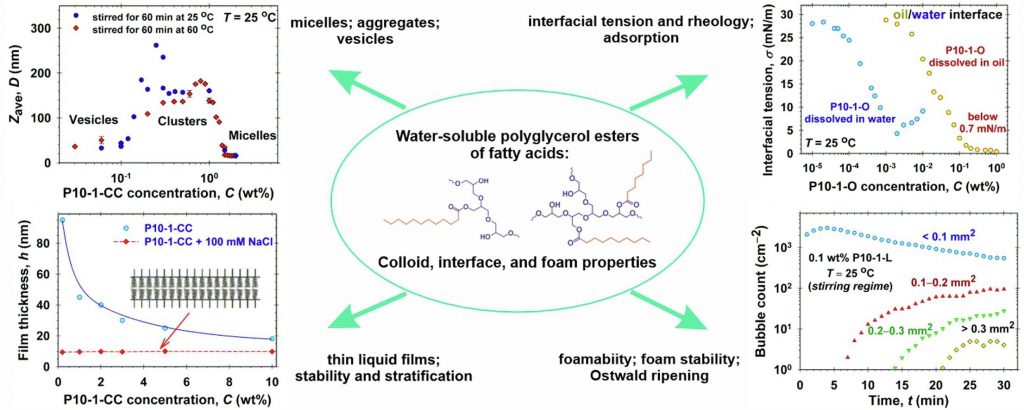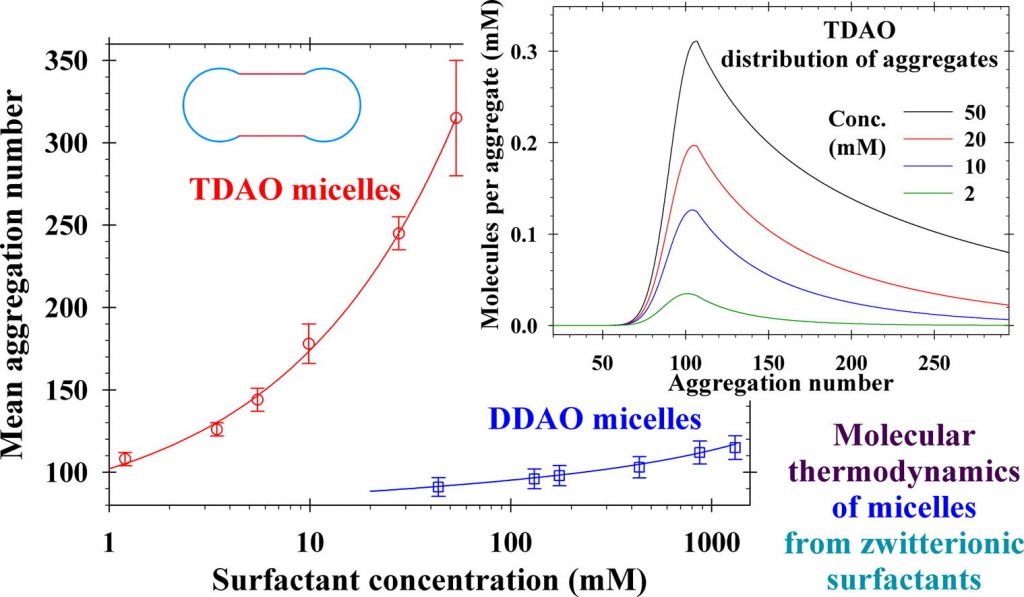
Mihail T. Georgiev, Ph.D.
Interests
- Hydrocolloids
- Complex fluids
- Surface and Interface
Publications
Most recent publications
Colloid, interface, and foam properties of water-soluble polyglycerol esters solutions
Hypothesis
Polyglycerol esters of fatty acids are generated via the esterification of a polydisperse mixture of polyglycerol with naturally derived fatty acids. The polymerization process of polyglycerol results in the production of various oligomers, ranging from di-, tri-, and higher-order forms, which contribute to the complexity of final products. The combination of complementary experimental techniques and adequate theoretical interpretations can reveal the wide variety of their physicochemical properties.
Experiments
The colloid and interface properties of polyglyceryl mono-laurate, mono-stearate, mono-oleate, and a mixture of mono-caprylate and mono-caprate esters solutions were characterized by measurements of the electrolytic conductivity, static and dynamic surface tension, aggregate and micelle sizes and distributions, thin liquid film stability and stratification, and solubility in aqueous and in oil phases. The formation, stability, and bubble size distribution of foams generated from polyglycerol esters aqueous solutions were systematically investigated.
Findings
The low concentrations of double-tail molecules and fatty acids in polyglycerol esters affect considerably their micellar, aggregation, and vesicle formations in aqueous solutions. The theoretical data interpretation of polyglycerol esters isotherms and thin liquid films data provide information on the adsorption energies, excluded areas per molecule, interaction parameters of molecules at interfaces, surface electrostatic potential, and the size of micelles. Polyglyceryl mono-oleate exhibits spontaneous emulsification properties. Short chain length polyglycerol esters have excellent foaming ability but relatively low foam stability. The optimal weight fractions of the short-chain polyglyceryl esters and polyglyceryl mono-stearate mixtures with respect to good foaminess and foam stability upon Ostwald ripening are obtained. The reported physicochemical characterization of the water-soluble polyglycerol esters could be of interest to increase the range of their applicability in practice.

Growth of giant micellar aggregates: Quantitative theory vs experiments
The concentrated surfactant solutions have a wide application in industry, oil recovery, drug delivery, turbulent drag reduction, etc. The competition between the companies-producers has led to use of new kind of formulations to improve: washing action; skin and eye irritation; stability and durability; biodegradability; tolerance to hard water. Here, we present a review on the state of the art and our contributions to the molecular thermodynamic theory and experiment on the growth of giant micellar aggregates. Despite the considerable advances in theory and computer simulations, agreement with experimental data has been achieved only in isolated cases. Our predictive molecular thermodynamic approach accounts for the different contributions to the micellar scission energy in the case of nonionic, zwitterionic and ionic surfactant solutions and their mixtures. Excellent agreement was achieved between the theoretical model and experimental data for wormlike surfactant micelles at various concentrations of salt and temperatures. At high salt concentrations, the model also predicts loss of chemical equilibrium, which implies a transition to self-assemblies of other morphology or the onset of crystallization and phase separation. The results have applications for the design of new products and nanostructured materials.
Investigation of cationic surfactants adsorption behaviour on silicon wafers using imaging ellipsometry
The research paper explores the adsorption properties of cationic surfactants on silicon wafers through imaging ellipsometry. The objective of this research is to shed light on the layer structures formed by cationic surfactants, specifically those based on dimethyl ammonium chloride, on silicon wafers. The study involved the deposition of three distinct cationic surfactants on the wafer’s surface, followed by the measurement of the adsorption layers formed. The findings reveal the creation of thin, smooth, and irregular adsorption layers. Interestingly, no correlation was found between the thickness of the adsorption layer and the surfactant tail’s chain length. The research underlines the significant role which the imaging ellipsometry can have for studying surfactants’ adsorption properties on surfaces, contributing to their optimal usage in various fields.
Analytical modeling of micelle growth. 5. Molecular thermodynamics of micelles from zwitterionic surfactants
Hypothesis: The critical micelle concentration, aggregation number, shape and length of spherocylindrical micelles in solutions of zwitterionic surfactants can be predicted by knowing the molecular parameters and surfactant concentrations. This can be achieved by upgrading the quantitative molecular thermodynamic model with expressions for the electrostatic interaction energy between the zwitterionic dipoles and micellar hydrophobic cores of spherical and cylindrical shapes. Theory: The correct prediction of the mean micellar aggregation numbers requires precise calculations of the free energy per molecule in the micelles. New analytical expressions for the dipole electrostatic interaction energy are derived based on the exact solutions of the electrostatic problem for a single charge close to a boundary of spherical and cylindrical dielectric media. The obtained general theory is valid for arbitrary ratios between dielectric constants, radii of spheres and cylinders, positions, and orientations of dipoles. Findings: The detailed numerical results show quantitatively the effects of the micelle curvature and dielectric properties of the continuum media on the decrease of the dipole electrostatic interaction energy. Excellent agreement was achieved between the theoretical predictions and experimental data for the critical micelle concentration, size and aggregation number of zwitterionic surfactant micelles. This study can be extended to mixed micelles of zwitterionic and ionic surfactants in the presence of salt to interpret and predict the synergistic effect on the rheology of solutions.

Flow reactor for preparation of lipid nanoparticles via temperature variations
Lipid nanoemulsions and nanosuspensions are used as flavor carriers and bubble stabilizers in soft drinks and foods, as well as delivery vehicles for lipophilic drugs in pharmaceutics. Common techniques for their formation are the high-pressure and ultrasonic homogenizers. These techniques dissipate most of the input energy, which results in excessive heating and generation of free radicals that might modify sensitive ingredients. Low energy methods are also used in some applications, but they have specific limitations restricting their universal use. In the current study, we propose an alternative approach – a flow reactor with a variable temperature, which utilizes the lipids’ polymorphic transitions to induce spontaneous fragmentation of the lipid microparticles into nanoparticles. The reactor allows us to obtain emulsions or suspensions with particle diameters tunable between 20 and 800 nm when appropriate surfactants, temperature profiles, and flow rates are applied. The fragmentation is comparable to that in a high-pressure homogenizer at ca. 500 bars or higher, without creating emulsion overheating or cavitation typical for the conventional methods. The flow reactor can be scaled up to industrial applications using simple scaling rules.


